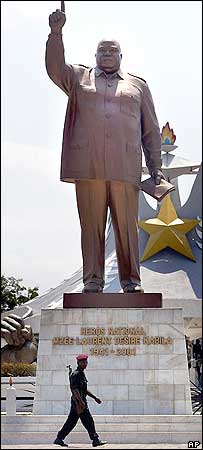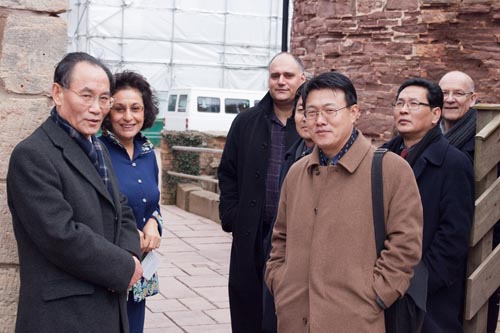Interview Blog, Germany
(click here for all their North Korea-related interviews)
“Phoenix Commercial Ventures Ltd is a venture capital company that offers investors business and investment opportunities in the DPRK” – Interview with Ken Frost (CFO of Phoenix)
Klaus-Martin Meyer: Mr. Frost, you are member of the Board of Phoenix Commercial Ventures Ltd, a company that offers investors business and investment opportunities in the Democratic People’s Republic of Korea (DPRK) otherwise known as North Korea. Would you mind introducing yourself and your company as well to our readers?
Ken Frost: Phoenix Commercial Ventures Ltd is a venture capital company that offers investors business and investment opportunities in the DPRK, enabling them to take advantage of the economic reforms that are taking place there.
Phoenix is owned and run by four experienced professionals, who are based in London, Paris and the DPRK. The Board has between them many years of international business experience, and an invaluable network of well placed contacts. Phoenix offers a unique service, by being able to offer direct access to the DPRK.
Phoenix Commercial Ventures Ltd specialises in project finance in the DPRK. As is well known, the business environment is difficult, and the company targets very specific investment projects; these are small enough to manage and have the capacity to generate foreign currency, either through export or import substitution.
Phoenix Commercial Ventures Ltd maintains an office in Pyongyang, almost the only European company to do so, and operates with the following specific aims:
• Identify commercially viable investment projects in the DPRK, on a case by case basis
• Identify reliable local partners for all forms of business in the DPRK, either trade or investment
• Seek overseas investment sources for such projects
• Minimise the risk in such projects, by taking responsibility for supervision of the local set-up procedures and management of the projects
The Board of Phoenix Commercial Ventures Ltd consists of nationals of the UK, France and the DPRK. The European flavour is enhanced by the fact that most of the counterparties and suppliers in the various projects are also European, and the DPRK government views Phoenix Commercial Ventures as a prime conduit for European business and investment in the DPRK.
One of the directors of Phoenix Commercial Ventures is also General Manager and CEO of the Daedong Credit Bank, the only western-invested foreign bank in the DPRK. Based in Pyongyang, this is a 70-30 joint venture between a UK financial management company based in Hong Kong and the Korea Daesong Bank, one of the main DPRK banks.
Phoenix Commercial Ventures is unique in having this connection with a reliable, locally based financial institution. The synergy benefits include a wider exposure to local business contacts in differing fields; as well as an additional degree of control, made possible by the fact that the various joint venture projects have to maintain their accounts with the bank.
We have a number of projects within DPRK, including two 50/50 joint ventures:
– Hana Electronics JVC, a consumer electronics company now ranked as one of the top three best performing joint ventures in DPRK, as assessed by the Ministry of Finance.
– Sinji JVC, whose main areas of operations are retail, software and bonded processing.
Full details about our company can be found on our website www.pcvltd.com
I am the CFO of Phoenix and am a chartered accountant with over twenty years international experience of FMCG industries, consumer electronics, rough diamond distribution and the Internet. I have worked in KPMG, Philips Electronics, De Beers and run my own Internet company. I am also a Scholar on Gerson Lehrman Group Councils.
In November 2007 I reached the finals of Accountant of the Year held by the Association of International Accountants at the President’s Awards Dinner 2007. This award is designed to recognise organisations’ accountancy stars.
In January 2007 I was awarded, based on recommendations from fellow members of the ICAEW, a New Year’s Honour by AccountingWeb. The award was for my services to the accountancy profession in opposing the merger of the ICAEW with other accountancy bodies.
In November 2006 I was awarded an honorary fellowship of the Institute of Professional Financial Managers (IPFM), for my services to the accountancy profession.
In January 2006 Accountancy Age placed me on their Financial Power List for 2006. I was 11th on their list of the top 50 of “The Ones To Watch”. The list identified the “most influential names to look out for” in the world of finance for 2006.
Klaus-Martin Meyer: We read on your website “offers investors business and investment opportunities in the Democratic People’s Republic of Korea (DPRK), enabling them to take advantage of the economic reforms that are taking place there.” Can you tell us what kind of opportunities this could be?
Ken Frost:There are three main areas of investment opportunities open to investors, which we can facilitate within the DPRK:
1 Small scale investments ($500K or less) yielding good levels of return (20% or more).
These investment opportunities are in local production (consumer goods, bonded processing, software etc) for domestic market consumption and export. These utilise the advantages that DPRK has over all the other countries in the region namely:
– 99% literacy
– skilled/disciplined/hard working workforce
– well educated workforce, many speak a good level of English
– lowest wage rates in the region
Phoenix has a number of opportunities that it can offer investors in this area; eg bonded processing, consumer manufacturing, clothing manufacturing and software development.
2 Natural resources
DPRK has proven abundant natural resources worth several trillion dollars; eg coal, gold, copper, titanium, lead, zinc, nephelite, nickel, magnesia, graphite etc.
The investment required would be of a higher order than the small scale investments above, $1M plus. The money would be used to bring existing mines back to production, by pumping out flood water and renewing worn out capital equipment.
Phoenix has, via its working relationship with CPEEC, a number or opportunities in the natural resource sector that it can offer genuine investors.
3 Infrastructure development
Clearly investment in infrastructure is the costliest form of investment. However, given the dilapidated state of the roads, railways, ports, electricity grid etc it is necessary if the economy is to be revived.
DPRK also has a keen interest in infrastructure development focussed on green/renewable energy areas.
Phoenix has on it books a profitable renewable energy project that would suit a serious, well financed and experienced green energy investor.
The DPRK is the final economic frontier and is a “green field” site. Its primary advantages are:
– Location (physical position between Russia, South Korea, China and in AP)
– Location (historical, all the major players now want to move forward)
– Location (resources, it has abundant rich resources both mineral and human capital – high literacy, well educated etc)
Klaus-Martin Meyer: What are the main differences between your company and a conventional venture capital company that is investing for example in internet our biotech companies?
Ken Frost: Companies such as those you mention are industry-specific, whereas ours is location-specific. Our company is relevant to people who might want to invest in the DPRK. We work in the DPRK and have a physical presence in the DPRK, other “conventional” venture capital companies do not.
Klaus-Martin Meyer: Are there any differences to other investment companies?
Ken Frost: We apply the same principles to potential investments as any other professional investment company, we look at:
– the risk
– the returns
– the quality of the local management
– the quality of the business plan
– the size of investment
– the share offered for that investment etc
We also pay very close attention to corporate governance issues such as; financial reporting, management structure and ethics etc. We have a code of conduct which can be seen on our website.
Phoenix Commercial Ventures Ltd is committed to being a responsible corporate citizen and to the pursuit of a sustainable future, both economic and social.
Phoenix Commercial Ventures Ltd adheres to three fundamental ethical principles:
– Integrity
– Competence
– Courtesy
To this end Phoenix Commercial Ventures Ltd has developed a Code of Conduct, which sets out to ensure that these principles are followed in its operations. The Code of Conduct governs Phoenix’s business decisions and actions. The Code applies equally to corporate actions, and to the behaviour of individual employees when conducting business on behalf of Phoenix.
We work very hard with our local management teams and business partners to ensure that international standards re reporting, corporate governance and ethics are understood and followed.
Klaus-Martin Meyer: What are your plans for the company’s future? How do you see Phoenix Commercial Ventures in five years time?
We see the coming period for Phoenix as that of being continued growth.
In our view there will be a major upswing in economic relations between the DPRK and other countries over the coming months/years. Phoenix Commercial Ventures is uniquely placed to take advantage of, and to respond to, that upswing.
We are one of the very few organisations to have made successful joint ventures in the DPRK. We are also one of the very few organisations to have people with many years’ experience, and cultural sensitivity, actually on the ground in Pyongyang. You cannot run a business by email!


